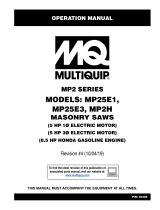
4 English
▶ Dust from materials such as paint containing lead, some types of wood, minerals and metal can be
harmful to health. Contact with or inhalation of the dust can cause allergic reactions and/or respiratory or
other diseases to the operator or bystanders. To reduce the amount of dust produced when cutting, we
recommend use of the wet cutting method. Make sure that the workplace is well ventilated. It is advisable
to wear a filter class P2 dust mask. Comply with national regulations applicable to the materials you will
be working with.
▶ Always hold the tool firmly with both hands on the grips provided. Keep the grips clean, dry and free
from oil and grease.
▶ If there is an unwanted increase in speed, set the run/stop switch to the "stop" position. Contact Hilti
Service.
▶ Releasing the throttle safety grip when the tool is running at full speed causes the tool to tip forward
slightly due to the braking torque. Be prepared for this and grip the tool securely with both hands on the
grips provided.
▶ Never use the tool without the guard (hood). Adjust the guard to the correct position. The guard must be
securely attached and positioned for maximum safety, so that the smallest possible part of the cut-off
wheel is exposed to the operator. Make sure that sparks created during use do not present a hazard. The
guard helps to protect the operator from broken wheel fragments, inadvertent contact with the cut-off
wheel and uncontrolled flying sparks.
▶ Do not touch rotating parts – risk of injury!
▶ Maintain a firm footing and balance at all times. This will allow you to control the product better, even
in unexpected situations. Avoid unusual postures. When using the product, hold it in such a way that
dust, flying sparks and possible flying fragments of the accessory tool or workpiece cannot hit you. Do
not lean over the cut-off wheel.
▶ Wear suitable work clothes. Do not wear jewelry or loose clothing. Keep your hair, clothing and gloves
away from moving parts. Loose clothes, jewelry or long hair can be snagged by moving parts.
▶ If the product or the cut-off wheel has been dropped or has fallen, check the product and the cut-off
wheel for damage. Change the cut-off wheel if necessary.
▶ Switch the product off before adjusting the guard or changing the cut-off wheel.
▶ Wear protective gloves also when changing the cut-off wheel. Touching the cut-off wheel presents a risk
of injury (cuts or burns).
▶ Avoid skin contact with the slurry created when using the wet cutting method.
▶ Cutting material containing asbestos is not permissible.
▶ Take breaks between working and do relaxation and finger exercises to improve the blood circulation in
your fingers. Exposure to vibration during long periods of work can lead to disorders of the blood vessels
and nervous system in the fingers, hands and wrists.
▶ Consult the responsible structural engineer, architect or person in charge of the building project before
starting work. Slits cut into load-bearing walls or other structures can influence the statics of the structure,
especially when reinforcing bars or load-bearing components are cut.
▶ If work involves break-through, always secure the area on the side opposite where the work is carried
out. Pieces of debris could drop out and/or fall down and injure other persons.
▶ Never leave the product running while unattended.
▶ Switch the engine off and wait until the cut-off wheel has come to a complete standstill before placing
the product on the ground, moving it to the next working position, or transporting it.
▶ Make sure that the pump cover is installed if you operate the product without an external water pump.
▶ Switch the product off after use.
▶ Maintain the product carefully. Check whether parts are broken or damaged to the extent that the
product is not in full working order. Have damaged parts repaired before using the product.
▶ To reduce the risk of injury, use only genuine Hilti tools and accessories.
▶ Have the product repaired only by qualified specialists using only genuine Hilti spare parts. The safety of
the product can thus be maintained.
▶ Comply with national health and safety requirements.
2.3 Electrical safety
▶ Before beginning work, check the working area for concealed electric cables or gas and water pipes.
External metal parts of the machine may give you an electric shock if you damage an electric cable
accidentally.
▶ Organize in advance the work to be performed, after examining the location. Check whether warning
signs have to be set up and a safe working distance from other persons defined.




















